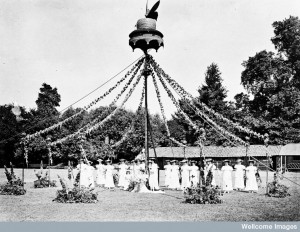I once wandered into a pagan festival in Edinburgh by accident. A friend and I had curiously followed the crowds and sound of drumming, ending up at Calton Hill Beltane. People painted blue or red danced past by torchlight, then a group of women in white. A marriage-like ceremony between a white-clad woman and a half-naked man concluded the procession. This was a celebration of spring, fertility, and controlled unruliness.
Bonfires, dancing around the maypole, sexual play: these fertility rituals were typical of May Day (also Beltane and Walpurgisnacht) across early modern Europe, which took place from April 30 to May 1. The garlanding of a May Queen with flowers and leaves represented healthy crops and young women danced around phallic symbols (maypoles).
Early modern Europe was an agrarian world with over 90% of the population living rurally. People anxiously watched for omens about weather and crops. A snowy February meant a fine summer; rain on Palm Sunday meant little hay. People used magical and religious means to control their environment, especially by reinforcing thresholds. By placing a shoe in the chimney, a householder hoped to keep evil from entering the house. To drive evil from their parishes, priests walked the boundaries.
Liminal times of year – points of transition – were considered risky, but powerful. Good Friday was a bad day to shoe horses or plant crops, but bread made then might cure all ills. In the liturgical calendar, Good Friday marked Christ’s death and the wait for his resurrection. May Day was a dangerous in-between period, too. Crops planted, people could only wait and hope. Despite the fertility rituals, couples who married or children conceived during May were thought to be unlucky.
The boundaries between natural and supernatural worlds were considered weak during liminal times. Germans believed that witches gathered together on Walpurgisnacht, and, more generally, people thought that spirits moved between the worlds all month. Sound familiar? The May celebrations mirrored those exactly six months away: Halloween and All Saints Day.
The merriness of May Day was real, but had a dark side. It was a perilous time when the dead walked and new crops were vulnerable. Modern May Day festivals like the one in Edinburgh are merely celebrations today, but once upon a time had a much more important purpose: survival.
Lisa Smith is an Associate Professor of History at the University of Saskatchewan. She writes on gender, family, and health care in England and France (ca. 1600-1800) and recently taught a course on natural and supernatural worlds in early modern Europe.

